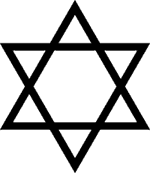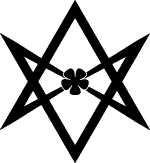Hexagram
(Difference between revisions)
|
Revision as of 23:57, 6 Jun 2005 LVX23 (Talk | contribs) |
Current revision Ash (Talk | contribs) |
||
| Line 1: | Line 1: | ||
| - | While the pentagram represents the microcosm, the hexagram can be said to represent the macrocosm. It's 6 points are accorded to the planetary bodies of Saturn, Jupiter, Mars, Sol, Venus, Mercury, and Luna. These in turn are related to 6 Sephiroth of the Tree of Life, as can be seen when aligning the Hexagram with the Central Pillar. If the Lesser Ritual of the Pentagram is elemental magick, then the Lesser Ritual of the hexagram involves planetary magick, as covered in the Aurum Solis work. | + | [[Image:Hexagram.gif|right]]While the [[pentagram]] represents the microcosm, the '''hexagram''' can be said to represent the macrocosm. Its six points are accorded to the planetary bodies of [[Saturn (astrology)|Saturn]], [[Jupiter (astrology)|Jupiter]], [[Mars (astrology)|Mars]], [[Sun (astrology)|Sol]], [[Venus (astrology)|Venus]], [[Mercury (astrology)|Mercury]], and [[Luna (astrology)|Luna]]. These in turn are related to six [[Sephiroth]] of the [[Tree of Life]], as can be seen when aligning the Hexagram with the Central Pillar. If the [[Lesser Ritual of the Pentagram]] is elemental [[magick]], then the [[Lesser Ritual of the Hexagram]] involves planetary magick. |
| - | Though it's often regarded as macrocosmic, closer inspection reveals that the hexagram is the union of elemental glyphs for Fire and Water and, as such, is also a symbol of the Great Work - the union of opposites. The symbol can be further analyzed to reveal the glyphs of Earth and Air as well, indicating that it's not simply macrocosmic, but includes the microcosm as well. From this it can be seen that the Hexagram is similar to the Rosy Cross. | + | Though it's often regarded as macrocosmic, closer inspection reveals that the hexagram is the union of elemental glyphs for Fire and Water and, as such, is also a symbol of the [[Great Work]] - the union of opposites. The symbol can be further analyzed to reveal the glyphs of Earth and Air as well, indicating that it's not simply macrocosmic, but includes the microcosm as well. From this it can be seen that the Hexagram is similar to the [[Rosy Cross]]. |
| - | Crowley searched for a means to create a hexagram composed of only a single, continuous line. His efforts brought him to the unicursal hexagram, which further codifies the symbolism contained within the hexagram, the Rosy Cross, and the Ankh. | + | ==Unicursal Hexagram== |
| + | [[Image:Unicursalhexagram.gif|right|frame|Crowley's Unicursal Hexagram]] | ||
| + | [[Aleister Crowley]] searched for a means to create a hexagram composed of one single, continuous line, as opposed to the dual triangles in the traditional form. His efforts led to the unicursal hexagram, which further codifies the symbolism contained within the hexagram, the rosy cross, and the [[ankh]]. | ||
| - | -this entry deserves more info- | + | ==See also== |
| + | *[[Rosy Cross]] | ||
| + | *[[Ankh]] | ||
| + | *[[Lesser Ritual of the Hexagram]] | ||
| + | *[[Greater Ritual of the Hexagram]] | ||
| + | [[Category:Symbols]] | ||
Current revision
While the pentagram represents the microcosm, the hexagram can be said to represent the macrocosm. Its six points are accorded to the planetary bodies of Saturn, Jupiter, Mars, Sol, Venus, Mercury, and Luna. These in turn are related to six Sephiroth of the Tree of Life, as can be seen when aligning the Hexagram with the Central Pillar. If the Lesser Ritual of the Pentagram is elemental magick, then the Lesser Ritual of the Hexagram involves planetary magick.Though it's often regarded as macrocosmic, closer inspection reveals that the hexagram is the union of elemental glyphs for Fire and Water and, as such, is also a symbol of the Great Work - the union of opposites. The symbol can be further analyzed to reveal the glyphs of Earth and Air as well, indicating that it's not simply macrocosmic, but includes the microcosm as well. From this it can be seen that the Hexagram is similar to the Rosy Cross.
Unicursal Hexagram
Aleister Crowley searched for a means to create a hexagram composed of one single, continuous line, as opposed to the dual triangles in the traditional form. His efforts led to the unicursal hexagram, which further codifies the symbolism contained within the hexagram, the rosy cross, and the ankh.
![[Main Page]](http://www.thelemapedia.org/images/logo.gif)

